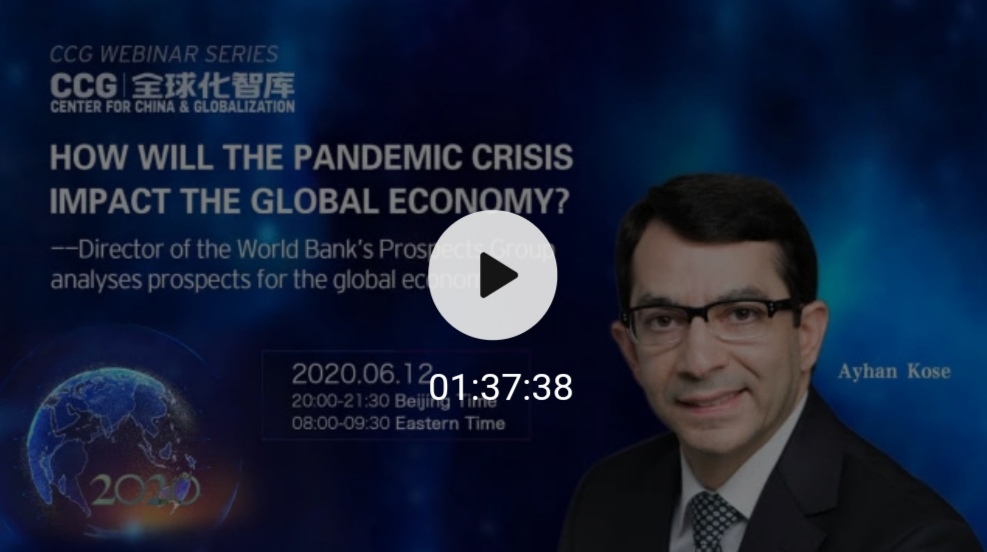[Video] World Bank discusses prospects for the global economy at CCG
Director of the World Bank’s Prospects Group analyses prospects for the global economy

[Video]
YouTube
Tencent
https://v.qq.com/x/page/l3078bbydzi.html
On June 12, Ayhan Kose, director of the World Bank Group’s Prospects Group, participated in a webinar held by the Center for China and Globalization (CCG) to discuss key issues raised in June 2020 Global Economic Prospects. This is the first time the World Bank has released and analyzed the report outside its headquarters in Washington DC.

This webinar was hosted by CCG President Wang Huiyao. Discussants included Martin Raiser, World Bank country director for China, South Korea and Mongolia; Justin Damien Guenette, senior economist in the Development Prospects Group of the World Bank, and Ekaterine T. Vashakmadze, senior economist at the World Bank. A total audience of over 800,000 in China and overseas watched the webinar through multiple platforms.

China and the World Bank have conducted fruitful cooperation and achieved mutual benefits over the past 40 years.
CCG President Wang Huiyao said that currently, there are more than 7.6 million cases of the coronavirus and more than 400,000 related deaths spanning more than 200 countries. In addition, the World Bank forecasts that global GDP will shrink by 5.2% in 2020 and by 7% in the developed world, with China being the only major economy growing positively at 1%. Wang said that this is the deepest recession since the Second World War. Therefore, countries and multilateral institutions around the world pay great attention to the current report issued by the World Bank.
Wang pointed out that in the past 40 years, China and the World Bank have conducted fruitful cooperation and achieved mutual benefits. Moreover, the World Bank has provided valuable loans for many large projects in China, laying a solid foundation for China’s modernization in many fields, especially infrastructure construction. Meanwhile, in its cooperation with the World Bank, China has strengthened regional cooperation, South-South cooperation, and knowledge exchange, making positive contributions to global poverty reduction and sustainable development.

East Asian countries performed relatively well in the fight against the pandemic; China has a profound impact on global value chains
Martin Raiser, World Bank country director for China, South Korea and Mongolia, stressed that the pandemic has injected uncertainty into the world economy. While it is very difficult to navigate or answer the potential challenges and opportunities at this point, the June 2020 Global Economic Prospects report tries to provide insights on many vital issues in today’s volatile world.
Raiser said that East Asian countries performed relatively well in the fight against the pandemic. He added that for most parts of East Asia, supply constraints are no longer a major restriction on economic growth and the problem now regards the decline of market opportunities because the whole world is facing economic contraction and loss of income. Raiser suggested that China, as a typical example, no longer faces supply constraints and should make careful decisions about real demand constraints, considering the far-reaching implications for regional and global value chains.
Raiser also pointed out that for China and some other emerging economies, the COVID-19 crisis may become an accelerator and catalyst for technological change and development. Moreover, with the growing scale of e-commerce and the increasing importance of modern digital technologies, these are likely to shift the structure of the economy permanently.
Raiser questioned if this crisis could be an opportunity to initiate some fundamental and far-reaching policy changes. He said that one of the most prominent discussions is how to ensure a better reconstruction for economic growth and a greener economy. He highlighted how, since all entities are closely integrated with each other, no country can isolate itself from the spread of the COVID-19 crisis.

Ayhan Kose, director of the World Bank Group’s Prospects Group, gives an in-depth interpretation of the June 2020 Global Economic Prospects.
Kose said the report outlines the outlook for the global economy and economic forecasts for countries monitored by the World Bank. In addition to these chapters, the report contains an analysis comparing the on-going crisis with similar global recessions since the 1870s. The report also includes many important issues, such as global value chains, regional macroeconomic impacts, how informality has worsened the pandemic, the permanent scars of the pandemic, and the impacts of low oil prices.
Kose highlighted four critical questions in the report:
Firstly, what are global prospects in the near-term? The World Bank answers that the COVID-19 crisis is the deepest and most synchronized global recession since the Second World War, as well as the first emerging market and developing economies (EMDEs) recession on record. The risks of the global economy are tilted to the downside.
Secondly, what are the likely long-term implications of COVID-19? An economic recession of this level will lead to weaker potential output and a decline in investment and productivity over the long term.
Thirdly, what is the global growth impact of cheap oil? It is likely the impact will marginal rather than significant on global growth and recovery. However, oil-exporting EMDEs are facing a sharp downturn.
Lastly, what are the policy priorities? The report suggests addressing the immediate health crisis and then pursuing reforms to reignite growth. Governments should also enhance debt and investment transparency. Apart from that, each country should coordinate policies globally.
China will be the only one who can fulfill with 1% positive growth
Kose pointed out that low mobility caused by the pandemic is severely affecting activities around the world. He said that economic activity, trade, capital flow and commodity prices have collapsed as governments have taken necessary measures in response to COVID-19. As a result, the net export experienced the largest one-month decline in April 2020. In March, visitor volumes fell by the largest margin, portfolio inflows to EMDEs saw the biggest drop since 2005, and the oil price index dropped by an unprecedented margin.
Kose said the World Bank expects the worst global recession since the Second World War, with the global economy expected to contract 5.2% this year and advanced economies contracting 7%. He added that emerging markets as a group have grown year after year, yet they will contract for the first time since records began in 1968, with a forecast contraction of 2.5%.
From a regional perspective, Kose said that all regions have experienced varying degrees of contraction. Specifically, East Asia and Pacific will be the least affected, growth prospects of -0.5% in 2020, still the slowest rate since 1967. Kose said that despite the slowdown, China will likely be the only major economy to achieve positive growth of 1% in the current global environment.
He said that Latin America and the Caribbean will face the greatest contraction of around 7.2%, the worst of all EMDE regions. Furthermore, other regions, such as Europe and Central Asia, the Middle East and North Africa, South Asia, and Sub-Saharan Africa will also experience great recessions.
Characteristics of the COVID-19 crisis
Kose said that the World Bank recognizes 14 global recessions since the 1870s. In each episode, the global economy experienced significant falls in per capita income decline and output. He summarized several characteristics of the COVID-19 crisis.
Firstly, this is the first global recession solely caused by a pandemic. Although the 1917 and 1921 recession occurred at the same time with the Spanish flu, the First World War was the main impact on the global economy.
Secondly, the 2020 crisis triggered by COVID-19 is the most severe since the Second World War, with an expected contraction of 5.2% for the world economy this year.
Thirdly, the recession this time is likely to be the deepest and the most destructive of all 14 global recessions since the 1870s.
Lastly, 2020 will see the largest number of economies in recession. The world economy is experiencing a synchronized recession, with contractions in per capita GDP in nearly 95% countries, a number even higher than in the Great Depression.
Kose expressed concerns about the rapidly increasing number of infections in Latin America, Sub-Saharan Africa, and South Asia since these regions are relatively less capable of detecting and containing the pandemic.
Kose emphasized that fragile prospects for the global economy depend on the duration of the pandemic. He said that in the pessimistic scenario, the contraction of the global economy could be as great as 8%, with a decline of 5% in EMDEs. In the optimistic scenario, the world economy still shrinks about 4%, twice the magnitude of the recession of the 2009 financial crisis.
Long-term implications of the COVID-19 crisis
Kose discussed the short-term and long-term implications of COVID-19.
In the short-term, economic activity will fall sharply. The question is, how will this affect the ability of the economy to grow? How to make full use of cutting-edge technologies to stimulate economic growth?
The potential long-term impacts of COVID-19 are a severe challenge to investment and output as well as the decline in the rate of human capital accumulation, which ultimately affects employment potential.
Kose said that in a typical recession, potential output falls by 5% over four years; if a recession were to coincide with a financial crisis, the decline would increase to 8%. He said that it will take a long time for the world economy to return to pre-pandemic levels of output, perhaps never. He further explained that the global economy was fragile before COVID-19, and the recovery has been slow since the 2009 financial crisis. In addition, the uncertainties associated with COVID-19 will affect investment for years. He added that school closures around the world have led to a huge drag on human capital accumulation, particularly in EMDEs. Moreover, the accumulation of physical capital has a long-term impact on investment and labor productivity, which will leave lasting scars.
Policy priorities in response to the crisis
Kose made several recommendations for policy responses to the pandemic.
He said that the policymakers firstly need to address the current health crisis and find ways to move the economy forward, which means reaching out to vulnerable families and providing the necessary support to viable companies.
He stressed that it is crucial to take the opportunity to think about what kind of future we want for future generations and to find environmentally-friendly ways to boost future economic growth. Kose also emphasized that greater transparency in debt and investment is more important than ever because of the high level of uncertainly and low levels of confidence around the world.
Kose also stated that policy coordination on a global scale is essential. He said that whenever there is a global crisis, there is a tendency to resort to protectionist measures. At this critical juncture, he suggested that countries should strengthen global policy coordination to ensure the smooth flow of supplies, especially medical equipment.
He said that the World Bank and the International Monetary Fund (IMF) continue to provide necessary supports for EMDEs, which are facing serious challenges in debt servicing, and that these policies play a key role in long-term growth prospects. Countries should coordinate their global policies to address global challenges, including public health, information transparency, the global trade and financial system, and climate change.
Kose concluded by saying that the COVID-19 crisis is devastating and the economic recovery will be very slow. He said that while we cannot resolve the situation with ready-made models, we can respond actively with timely and comprehensive policies.





